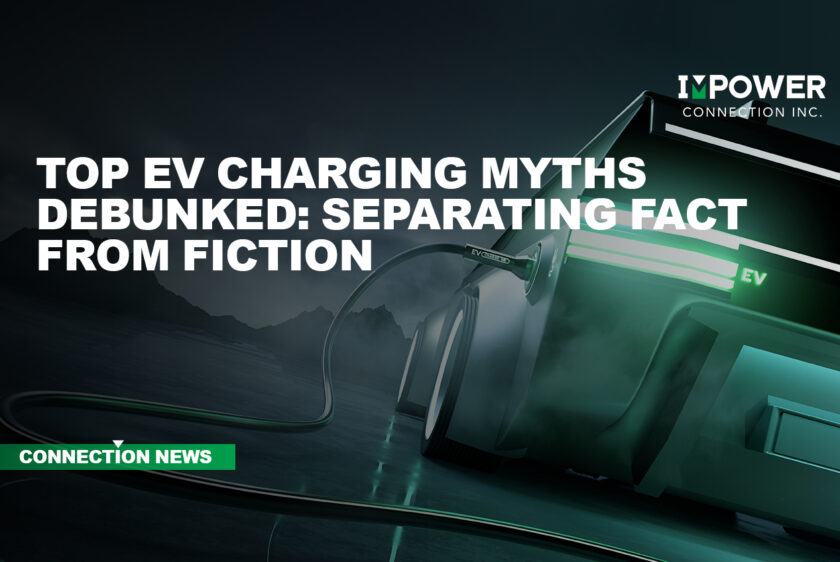In 2023, sales of electric vehicles (EVs) worldwide are expected to grow by 35%. It’s projected that EVs will comprise 18% of the overall car market this year – up from just 4% in 2020. Along with this explosive growth, misconceptions and rumors about EV charging have also emerged. Impower Connection, your trusted source for debunking common EV charging myths, is committed to providing accurate information about electric vehicle charging. Here, we will separate fact from fiction to empower you with accurate knowledge about EV charging.
1. Myth: EV Charging is Slow and Inconvenient
Fact: EV charging times vary depending on the charging station and the vehicle’s battery capacity. While some charging options, such as Level 1 charging from a standard household outlet, are slow, Level 2 chargers and DC fast chargers offer significantly faster charging times. Level 2 chargers can fully charge an EV in 4-8 hours, and DC fast chargers can provide a significant charge in a short amount of time – up to 80% in as little as 20 minutes – ideal for longer trips.
2. Myth: EVs Have Limited Range and Cause Range Anxiety
Fact: Modern EVs have made significant advancements in range capabilities. Early models often produced range anxiety – the fear that an electric vehicle would leave its occupants stranded due to insufficient battery charge. Yet many EVs on the market today can travel over 200 miles on a single charge, and some exceed 300 miles. With expanding charging infrastructure and improved battery technology, range anxiety is becoming less of a concern. Strategic planning and utilizing available charging stations ensure peace of mind for longer journeys. The current $7.5 billion in spending that’s allocated to build-out a national infrastructure network will further alleviate range anxiety and enable cross country travel in EVs.
3. Myth: EV Charging Damages the Electrical Grid
Fact: EV charging infrastructure is designed to work in harmony with the electrical grid. Charging stations use load management technology to distribute and optimize power usage. Smart charging systems can adjust charging rates based on grid demand, minimizing strain on the grid during peak periods. EVs can also serve as a valuable resource for grid stabilization and energy management. An emerging way that EVs positively impact the electrical grid is V2G, short for Vehicle to Grid. V2G enables vehicles to share unused power and even sell their charge to the power grid when needed. Microgrids, which are small-scale and operate independently or collaboratively, are also a method of grid stabilization and resiliency. Growing in popularity, microgrids combine a variety of fuels such as hydrogen, wind, propane and solar to create stored energy that can power chargers.
4. Myth: EV Charging is Expensive
Fact: Charging an EV is often cheaper than refueling a conventional gasoline-powered vehicle. The cost of electricity is typically 50% lower than gasoline, resulting in lower fueling costs over time. Additionally, there are various incentives, rebates, and time-of-use electricity rates that further reduce charging expenses. With careful planning and utilization of cost-effective charging options, and with new lower cost EVs, EV charging can be economical. It’s also proven to save significantly on total cost of ownership for vehicle fleets – even with the considerable initial investments of new vehicles and charging systems. In fact, fleets have the greatest opportunity for a quick payback on converting to electric power.
5. Myth: EV Charging Stations Are Scarce and Inconvenient to Find
Fact: The EV charging infrastructure is rapidly expanding, with charging stations becoming increasingly accessible. Many public locations – including shopping centers, parking garages and highway rest stops -offer charging stations. Numerous smartphone apps and online maps help EV owners locate nearby charging stations, making it convenient to find charging options anywhere. The Plugshare app and even Google can be used to find nearby chargers, with more charging sites being added every week and reviews available just like stores and restaurants receive.
Conclusion:
Experts expect to see 14 million in EV sales worldwide by the end of this year. The growth of EVs doesn’t show any signs of slowing down. When fact is separated from fiction, it’s easy to understand why EV sales continue to break new records.
It’s also easy to understand why EV charging is becoming increasingly convenient, fast, and accessible, as businesses and governmental entities search for charging solutions. There are more than 47,000 public electric vehicle charging stations in the United States, and that number continues to increase as more people adopt EVs. With expanding charging infrastructure and advancements in technology, EVs are a viable and sustainable transportation solution and revenue generator.
At Impower Connection, we are committed to providing reliable information to help you make informed decisions about EV charging. Whether you want to attract customers with charging stations, create a new revenue stream or build a new EV charging environment for your commercial fleet, Impower Connection is your partner to provide comprehensive charging solutions.
Visit our website at www.impowerconnection.com to learn more about EV charging and discover how we can assist you in implementing reliable and efficient EV charging infrastructure. Let us help you embrace the benefits of EV charging.







